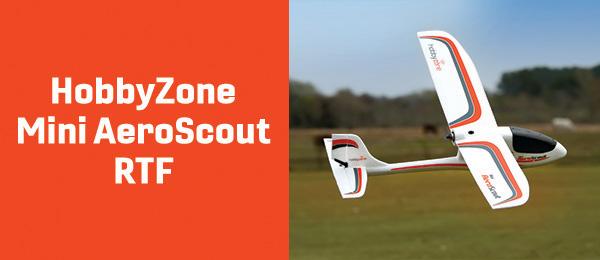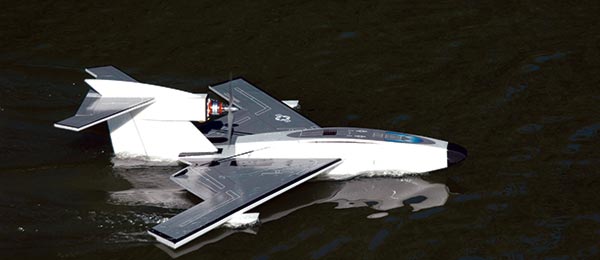Written by Fitz Walker
Same great configuration in a smaller package
As seen in the Spring 2021 issue of Park Pilot

The model comes ready to fly with only minimal assembly needed.
SPECIFICATIONS:
Type: Foam trainer
Wingspan: 30.3 inches
Length: 21.3 inches
Weight: 120 grams (as flown)
Battery: 1S 800 mAh 3.7-volt LiPo
Radio: Three-channel (included)
Price: $99.99
Info: horizonhobby.com
Features:
>> Easy to fly
>> Easily transportable
>> Powerful electric motor for excellent performance and flight times up to 10-plus minutes
>> Aircraft can take off from and land on smooth surfaces using the included landing gear and steerable tail wheel
>> 100% complete including a controller/ transmitter, battery, and charger
The build: The Mini AeroScout comes as a completely ready-to-fly package that includes a transmitter, batteries, and a charger. Nothing else is needed to get it into the air. Even the box doubles as a carrying case for convenient transportation to the flying field.
The airplane’s construction is EPO foam, which is very smooth to the touch and appears durable. All decals are applied at the factory.
There was little to assemble when the airplane was first taken out of the box. All that was needed was to add Velcro to the battery and battery tray, screw on the wing with a single screw, and snap on the landing gear. This task takes roughly as much time to complete as it took me to write the previous sentence. I would, however, recommend adding a thin layer of epoxy to the battery tray for better adhesion of the Velcro tape.
The included transmitter comes bound to the model and has three functions: throttle, elevator, and rudder. It is somewhat on the small side, but not too small for adult-size hands. There are digital trim buttons for all axes and the pilot can change the sensitivity on the controls.
The system is not Spektrum compatible, so it can’t be bound to any of the current line of Spektrum transmitters. A nice touch is that the model features a steerable tail wheel.
The battery is an 800 mAh single-cell LiPo pack. I had no problem obtaining the recommended center of gravity with this battery. It takes approximately an hour to charge the LiPo via a USB charger.
The motor is a standard brushed-type swinging a 41/4-inch propeller. The total ready-to-fly weight of the airplane is a paltry 120 grams (4.2 ounces). This means the Mini AeroScout is best flown on relatively calm days with a wind speed of less than 10 mph.
A small brushed can motor provides adequate power for the Mini AeroScout.
Power is provided by a single-cell LiPo battery.
The flight: My first flight attempt was a hand launch with the battery positioned at the forward limit in the fuselage. The model dipped downward a bit after release, requiring me to hold some up-elevator until the speed built up.
Once on step, a few clicks of rudder trim were needed to get it tracking straight. The power was adequate, with the little brushed motor doing surprisingly well, but don’t expect spectacular climbouts. This model must be flown on the wing, which is a good thing for new fliers to learn.
With that stated, the mini AeroScout doesn’t need much speed to stay in the air. On the second flight, I moved the battery back slightly and noticed less of a drop on hand launch. As I progressively reduced throttle, I could continue to do level circuits at half throttle without issue. Because the model uses rudder only for turning, there is a small amount of delay to kick the model into a turn when commanded. But after a few minutes of flying, I found it easy to adjust to rudder-only flying. I also performed some takeoffs from a paved surface and found that the tail wheel worked quite well.
It can do some basic aerobatics, but you will have to think ahead before performing them. I could coax a passable loop after a momentary dive—mild snap rolls too, if the speed was high enough. And, of course, stall turns. If you really let the speed build up in a dive, you can jerk it into a sort of snap-turn, but the Mini AeroScout is not designed for aerobatics. It is much more at home flying lazy circuits in tight spaces.

The paint scheme is vibrant enough to be visible from long distances.
It is an airplane that you can fly guilt free in a schoolyard, parking lot, or even in an indoor venue. I was easily able to fly it in an area the size of a baseball field. I also flew it far away with no range issues.
As a trainer, it does have some inherent self-rightening abilities. There is no gyro or electronic stabilization, but the basic aerodynamics tend to self-level the model if you take your hands off the controls. If one does find the controls too sensitive, dual rates can be activated by momentarily pressing down on the right control stick. This will desensitize the controls on both the rudder and elevator. Control is still good on the low rates, but I did find it a bit mushy in the power-off glide.
Flight times were also impressive with the included battery. With careful throttle use, I was able to get 10-minute flights. I let several other people fly the Mini AeroScout, including a teenager and my photographer’s 12-year-old son, Ryan. Although Ryan has some RC experience, he’s still a relatively new flier, yet he took to the AeroScout quickly and needed no assistance.
The Mini AeroScout is a joy to fly, in a relaxing way. It’s a convenient model to keep around for some schoolyard fun. Its lightweight, pusher-motor configuration means it should be difficult to significantly damage it. This is a true park flyer.

The Mini AeroScout can be easily hand launched, as Fitz Walker demonstrates.
Photos by Lee Ray and Fitz Walker
By Lee Ray | [email protected]









